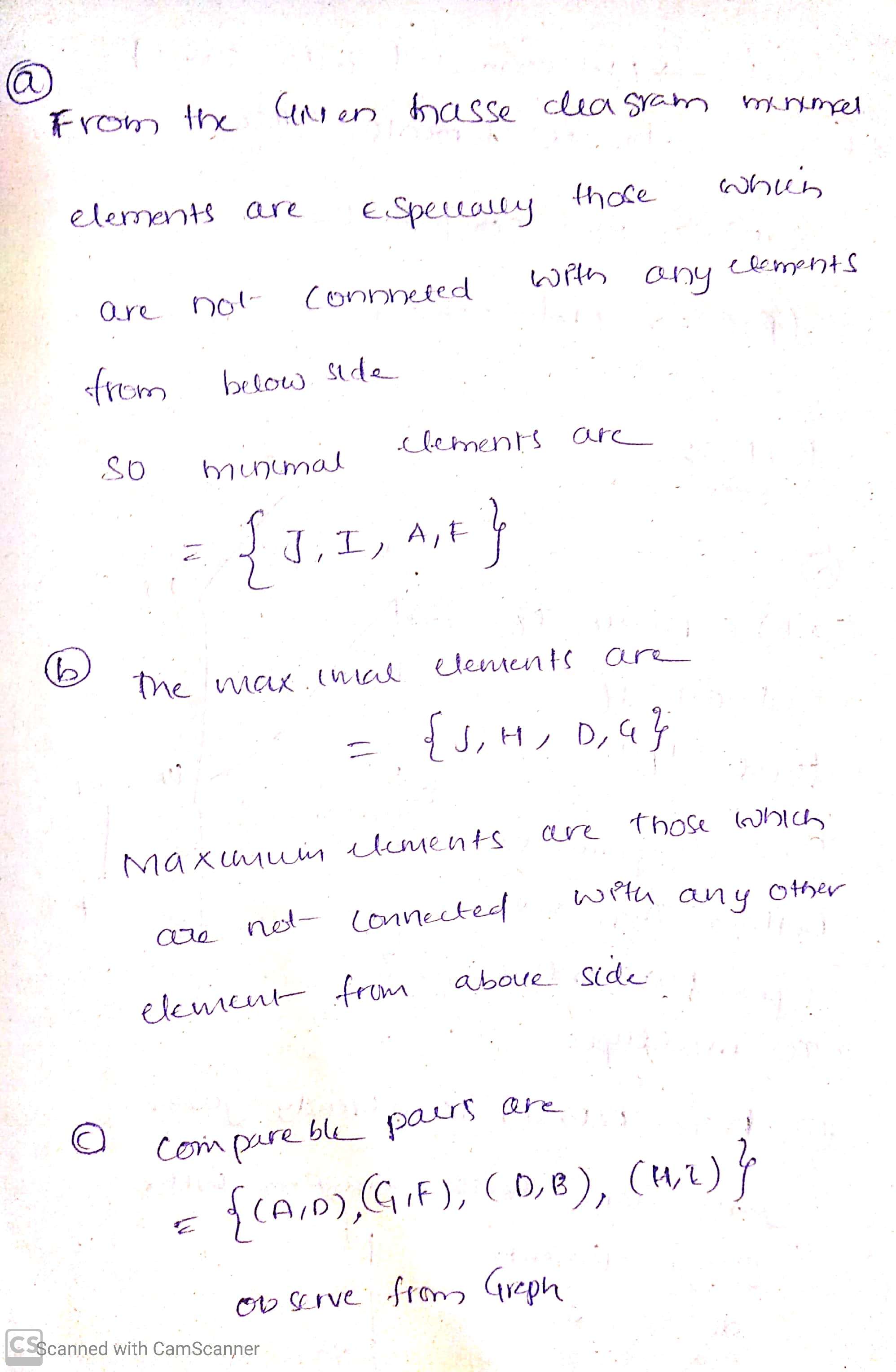nent.tex- TeXstudio part label tiny >> 8 of 10 Part 1. The drawing below shows a Hasse diagram for a partial order on the set {4, B. C, D. E, F. G. H. I, J} C. E B Figure 3: A Hasse diagram shous 10 vertices and 8 edges. The vertices, rep- resented by dots, are as follows: verter J; vertices H and I are aligned vertically to the right of verter J; vertices A, B. C, D, and E forms a closed loop, which is to the right of vertices H and I; verter G is inclined upward to the right of verter E; and verter F is inclined dounward to the right of verter E. The edges, represented by line segments, between the vertices are as follows: Verter J is connected to no verter; a vertical edge connects vertices H and I; a vertical edge connects vertices B and C; and 6 inclined edges connect the following vertices, A and B, C and D, D and E, A and E, E and G, and E and F. (a) What are the minimal elements of the partial order? (b) What are the maximal elements of the partial order? (c) Which of the following pairs are comparable?
nent.tex- TeXstudio part label tiny >> 8 of 10 Part 1. The drawing below shows a Hasse diagram for a partial order on the set {4, B. C, D. E, F. G. H. I, J} C. E B Figure 3: A Hasse diagram shous 10 vertices and 8 edges. The vertices, rep- resented by dots, are as follows: verter J; vertices H and I are aligned vertically to the right of verter J; vertices A, B. C, D, and E forms a closed loop, which is to the right of vertices H and I; verter G is inclined upward to the right of verter E; and verter F is inclined dounward to the right of verter E. The edges, represented by line segments, between the vertices are as follows: Verter J is connected to no verter; a vertical edge connects vertices H and I; a vertical edge connects vertices B and C; and 6 inclined edges connect the following vertices, A and B, C and D, D and E, A and E, E and G, and E and F. (a) What are the minimal elements of the partial order? (b) What are the maximal elements of the partial order? (c) Which of the following pairs are comparable?
Advanced Engineering Mathematics
10th Edition
ISBN:9780470458365
Author:Erwin Kreyszig
Publisher:Erwin Kreyszig
Chapter2: Second-order Linear Odes
Section: Chapter Questions
Problem 1RQ
Related questions
Question
Discrete Mathematics

Transcribed Image Text:nt.tex TeXstudio
part
label
tiny
8 of 10
(c) Which of the following pairs are comparable?
(A, D), (J, F), (B, E), (G, F), (D, B), (C, F), (H, I), (C, E)
Part 2. Each relation given below is a partial order. Draw the Hasse diagram
the partial order.
(a) The domain is {3, 5, 6, 7, 10, 14, 20, 30, 60}. r<y if r evenly divides
snhu
(b) The domain is (a, b, c, d, e, f}. The relation is the set:
{(b, e), (b, d), (c, a), (c, f), (a, ). (a, a), (b, b), (c, c), (d, d), (e, e), (f. )}

Transcribed Image Text:nent.tex - TeXstudio
part
label
tiny
>>
8 of 10
Part 1. The drawing below shows a Hasse diagram for a partial order on the set
{4, B, C, D. E. F. G. H, I, J}
B
Figure 3: A Hasse diagram shows 10 vertices and 8 edges. The vertices, rep-
resented by dots, are as follows: verter J; vertices H and I are aligned vertically to
the right of verter J; vertices A, B, C, D, and E forms a closed loop, which is to
the right of vertices H and I; verter G is inclined upward to the right of verter E;
and verter F is inclined dounward to the right of verter E. The edges, represented
by line segments, between the vertices are as follows: Verter J is connected to no
verter; a vertical edge connects vertices H and I; a vertical edge connects vertices
B and C; and 6 inclined edges connect the following vertices, A and B, C and D,
D and E, A and E, E and G, and E and F.
(a) What are the minimal elements of the partial order?
(b) What are the maximal elements of the partial order?
(c) Which of the following pairs are comparable?
Expert Solution
Step 1

Step by step
Solved in 2 steps with 2 images

Recommended textbooks for you

Advanced Engineering Mathematics
Advanced Math
ISBN:
9780470458365
Author:
Erwin Kreyszig
Publisher:
Wiley, John & Sons, Incorporated

Numerical Methods for Engineers
Advanced Math
ISBN:
9780073397924
Author:
Steven C. Chapra Dr., Raymond P. Canale
Publisher:
McGraw-Hill Education

Introductory Mathematics for Engineering Applicat…
Advanced Math
ISBN:
9781118141809
Author:
Nathan Klingbeil
Publisher:
WILEY

Advanced Engineering Mathematics
Advanced Math
ISBN:
9780470458365
Author:
Erwin Kreyszig
Publisher:
Wiley, John & Sons, Incorporated

Numerical Methods for Engineers
Advanced Math
ISBN:
9780073397924
Author:
Steven C. Chapra Dr., Raymond P. Canale
Publisher:
McGraw-Hill Education

Introductory Mathematics for Engineering Applicat…
Advanced Math
ISBN:
9781118141809
Author:
Nathan Klingbeil
Publisher:
WILEY

Mathematics For Machine Technology
Advanced Math
ISBN:
9781337798310
Author:
Peterson, John.
Publisher:
Cengage Learning,

